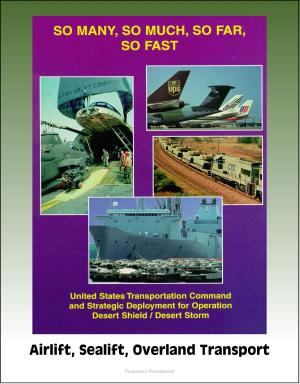The Wings of the Dragon: PLA Air Force (PLAAF) Rapid Conventional Force Projection: Beyond Taiwan? China's Use of Force, Intent, Potential Force Scenarios, Combat Enablers, Bomber Capability
Nonfiction, History, Asian, China, Military, Aviation| Author: | Progressive Management | ISBN: | 9781311999986 |
| Publisher: | Progressive Management | Publication: | April 1, 2016 |
| Imprint: | Smashwords Edition | Language: | English |
| Author: | Progressive Management |
| ISBN: | 9781311999986 |
| Publisher: | Progressive Management |
| Publication: | April 1, 2016 |
| Imprint: | Smashwords Edition |
| Language: | English |
Professionally converted for accurate flowing-text e-book format reproduction, this unique book assesses the state of capability within the PLA Air Force, both at present and also based on a projection for 2020, in order to determine the range of options for China's leadership to rapidly project conventional force in terms of coercive, assertive or constructive actions. It is clear from the analysis that the PLAAF retains only a limited capability at present, and somewhat predictably, will possess a better capability in 2020. However, neither case presents a challenge for US and allied supremacy in the air. As far as conventional force projection capabilities in terms of airpower are concerned, any "near-peer" threat which China might represent lies well into the future, after a certain set of decisions which would need to be made by Chinese leaders with respect to developing additional capabilities beyond those currently planned. In response, the United States should focus less on countering and more on engaging China to support its growth into a responsible regional military power—while carefully watching for any sign that China is pursuing conventional airpower capabilities to act with force beyond China's near periphery.
INTRODUCTION * Analytical Method * BEYOND TAIWAN: POTENTIAL CONVENTIONAL FORCE SCENARIOS * Strategic Culture and China's Use of Force * Current Issues of Strategic Interest to China * Geographic Hot Spots * Resources - and How They Get to China * Humanitarian Relief * ELEMENTS OF CHINESE MILITARY POWER * China's Conventional Airpower: Combat Platforms * China's Conventional Airpower: Combat Enablers * PLAAF Airborne Capability * DOCTRINE AND READINESS FOR POWER PROJECTION * PLAAF Doctrine * PLAAF Readiness * Basic Indicators: Flight Hours and Night/Adverse Weather Training * Complex Indicators: Air refueling and Airborne Training * Review of Recent Major Exercises * What You Typically Don't See: Logistics and Supply of Expeditionary Operations * ASSESSMENT OF PLAAF RAPID CONVENTIONAL FORCE PROJECTION * Analysis of the Scenarios: What Can the PLAAF Do Now * 2005: Coercive Scenario * 2005: Assertive Scenario. * 2005: Constructive Scenario * A Look to the Future: PLAAF Force Projection Capabilities in 2020 * 2020: Coercive Scenario * 2020: Assertive Scenario * 2020: Constructive Scenario * IMPLICATIONS FOR US NATIONAL SECURITY STRATEGY * The Question of China's Intent * Distinctions in Capability * CONCLUSION * BIBLIOGRAPHY * FOOTNOTES
As China continues to modernize its military, it is clear that the capabilities of the People's Liberation Army (PLA) are being built to fight and win in a struggle over Taiwan. However, despite China's stated intent, this build-up has raised alarm in other Asia-Pacific states, including the United States. In essence, they ask of the PLA's modernization: What does this mean beyond Taiwan? What kind of force projection capabilities does the PLA currently possess, and what can be expected in the future? And what are the implications for US national security if and when China is able to rapidly project conventional force beyond Taiwan?
This paper attempts to answer these questions through an assessment of the PLA's rapid conventional force projection capabilities. While the Taiwan scenario has been the subject of intense analysis and debate, the larger questions of how a PLA built to win in Taiwan can be used elsewhere have been considered but have not been the subject of detailed review. This analysis attempts to provide a starting point for that discussion. By design, the focus here is more on capability rather than intent. While it is certainly important to understand and assess China's intent should it ever feel compelled to use military force, it is worth noting that a state's intent can often change rapidly due to its changing domestic circumstances or by virtue of outside pressures induced by international events.
Professionally converted for accurate flowing-text e-book format reproduction, this unique book assesses the state of capability within the PLA Air Force, both at present and also based on a projection for 2020, in order to determine the range of options for China's leadership to rapidly project conventional force in terms of coercive, assertive or constructive actions. It is clear from the analysis that the PLAAF retains only a limited capability at present, and somewhat predictably, will possess a better capability in 2020. However, neither case presents a challenge for US and allied supremacy in the air. As far as conventional force projection capabilities in terms of airpower are concerned, any "near-peer" threat which China might represent lies well into the future, after a certain set of decisions which would need to be made by Chinese leaders with respect to developing additional capabilities beyond those currently planned. In response, the United States should focus less on countering and more on engaging China to support its growth into a responsible regional military power—while carefully watching for any sign that China is pursuing conventional airpower capabilities to act with force beyond China's near periphery.
INTRODUCTION * Analytical Method * BEYOND TAIWAN: POTENTIAL CONVENTIONAL FORCE SCENARIOS * Strategic Culture and China's Use of Force * Current Issues of Strategic Interest to China * Geographic Hot Spots * Resources - and How They Get to China * Humanitarian Relief * ELEMENTS OF CHINESE MILITARY POWER * China's Conventional Airpower: Combat Platforms * China's Conventional Airpower: Combat Enablers * PLAAF Airborne Capability * DOCTRINE AND READINESS FOR POWER PROJECTION * PLAAF Doctrine * PLAAF Readiness * Basic Indicators: Flight Hours and Night/Adverse Weather Training * Complex Indicators: Air refueling and Airborne Training * Review of Recent Major Exercises * What You Typically Don't See: Logistics and Supply of Expeditionary Operations * ASSESSMENT OF PLAAF RAPID CONVENTIONAL FORCE PROJECTION * Analysis of the Scenarios: What Can the PLAAF Do Now * 2005: Coercive Scenario * 2005: Assertive Scenario. * 2005: Constructive Scenario * A Look to the Future: PLAAF Force Projection Capabilities in 2020 * 2020: Coercive Scenario * 2020: Assertive Scenario * 2020: Constructive Scenario * IMPLICATIONS FOR US NATIONAL SECURITY STRATEGY * The Question of China's Intent * Distinctions in Capability * CONCLUSION * BIBLIOGRAPHY * FOOTNOTES
As China continues to modernize its military, it is clear that the capabilities of the People's Liberation Army (PLA) are being built to fight and win in a struggle over Taiwan. However, despite China's stated intent, this build-up has raised alarm in other Asia-Pacific states, including the United States. In essence, they ask of the PLA's modernization: What does this mean beyond Taiwan? What kind of force projection capabilities does the PLA currently possess, and what can be expected in the future? And what are the implications for US national security if and when China is able to rapidly project conventional force beyond Taiwan?
This paper attempts to answer these questions through an assessment of the PLA's rapid conventional force projection capabilities. While the Taiwan scenario has been the subject of intense analysis and debate, the larger questions of how a PLA built to win in Taiwan can be used elsewhere have been considered but have not been the subject of detailed review. This analysis attempts to provide a starting point for that discussion. By design, the focus here is more on capability rather than intent. While it is certainly important to understand and assess China's intent should it ever feel compelled to use military force, it is worth noting that a state's intent can often change rapidly due to its changing domestic circumstances or by virtue of outside pressures induced by international events.















